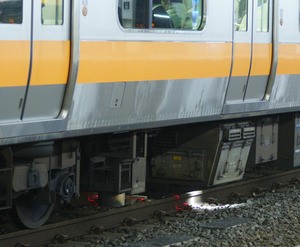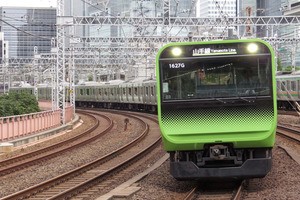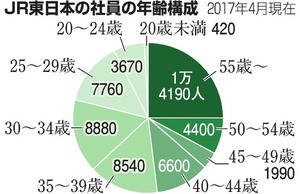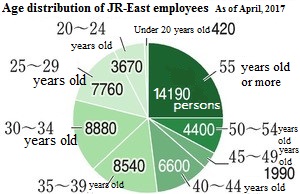Railway: Inspection (High-tech Rolling Stock) Japanese-English Translation Sample
Source: The Asahi Shimbun Article of May 5 2018
Original Text
鉄道の点検は列車にお任せ 首都圏でハイテク車両活躍中
千葉雄高 2018年5月5日15時58分
客を乗せて走りながら、列車自身が線路や車両の異常もチェックする――。そんな取り組みをJR各社が進めている。ベテラン作業員の引退で人手が不足しがちな鉄道設備の保守・点検を、最新のテクノロジーが補う。

様々なセンサーを搭載し、走りながら設備を常時監視する機能を持つJR東日本のE235系電車(同社提供)

線路を点検しながら走るJR東日本のE233系電車。車両下の装置から出るレーザーの赤い光が線路を照射している(同社提供)
赤い光が、レールを照らす。車両下の装置から照射されたレーザーが線路のゆがみを読み取る。カメラが線路を連続撮影し、画像診断システムでレールを留める金具や枕木の破損もチェックする――。
JR東日本の京浜東北線を走る電車「E233系」は、営業運転しながらレールを点検できる機能を持つ。2013年に同線で試行を始め、山手線、中央線などにも導入されつつある。不具合を早期に発見し、直ちに補修などの対応がとれるメリットがある。


現状、JR東日本は鉄道設備の保守・点検は「3カ月に1度」などの一定期間ごとに人の手で行っている。線路は保線員が定期的に歩いて目視で点検。車両は作業員が屋根に上ったり、下に潜ったりして異常がないか調べる。
だが、少子高齢化で労働人口が減り、人の手ばかりに頼れない。そこで、ハイテク機器の本格的な活用に乗り出した。
センサーの活用は、東海道新幹線の線路を点検する「ドクターイエロー」が知られている。だが、点検専用車は通常ダイヤの合間に走るため頻度が限られる。客を乗せて走る営業車両にセンサーを搭載すれば、効率がいいというわけだ。
E233系のほか、15年に山手線でデビューした「E235系」は車両自身の設備も常時監視する。各種センサーが架線から電気を受けるパンタグラフの動作、ドアを開閉するモーターの電流など700項目にわたるデータを取得して蓄積。どのような変化があれば故障が起きるかを研究している。
「スマートメンテナンス」と名付け、将来的には不具合を見つけるだけでなく、不具合の兆候を事前につかみ対処することを目指す。「人員減時代への対応だけでなく、進歩した技術で従来に勝る保守・点検方法を構築していきたい」と担当者は話す。
Translation
Trains entrusted with railway inspections, high-tech rolling stock serving functions in the metro area
By Yutaka Chiba | May 5, 2018 15:58
Trains that transport passengers, checking the railway track and rolling stock for abnormalities at the same time - JR companies are introducing these kinds of trains. State-of-the-art technologies save labor required for the maintenance and inspection of railway facilities as labor shortages tend to occur due to retirements of experienced workers.

A JR-East E235 Series train having the function of monitoring facilities all the time while running, with their various sensors mounted. (Courtesy of JR-East)

A JR-East E233 Series train, inspecting the railway track while running. A red laser beam emitted by a device under a vehicle is being applied to the railway track. (Courtesy of JR-East)
- Red beams illuminate the rail.
- Lasers emitted by the device under the vehicle detect distortions of the railway track.
- A camera continuously shoots the railway track, and an image diagnostic system checks for any damage of rail-fastening hardware and sleepers.
The E233 Series train, running on the Keihin Tohoku Line of JR-East, has the function of inspecting the rail during its revenue operation. The train was put into trial operations in 2013 on this line, and is starting its trial runs also on other lines such as the Yamanote Line and Chuo Line. One of the advantages of this train is that it enables early detection of failures, allowing immediate measures, such as repairs, to be taken.


The current maintenance system for the railway facilities of JR-East is to inspect them manually on a regular basis, for example, at an interval of three months. Railway tracks require regular, on-foot visual inspections performed by track maintenance workers. To inspect rolling stock, workers need to climb onto the roof, and/or crawl under the vehicles to check for any abnormality.
Now that the reduction in the workforce due to the declining birthrate and aging population makes it difficult to rely on manpower-based maintenance/inspection. It is under such circumstances that JR companies set out to start full-fledged utilization of high-tech equipment.
As an example of utilization of sensor technology, Doctor Yellow is known for its function of inspecting the Tokaido Shinkansen line track. However, in the case of an inspection car, which runs during intervals in normal services, the frequency of operation needs to be restricted. Therefore, a more efficient way is to enable rolling stock that transports passengers during revenue operation to sense.
Apart from the E233 Series, the E235 Series, which was put into service on the Yamanote Line in 2015, is also capable of monitoring the equipment of the rolling stock itself all the time. From the behavior of the pantograph receiving electricity from the overhead contact line, to the current of the motor for opening/closing doors, various types of sensors acquire the data for as many as 700 items. The accumulated data is used for research into the prediction of faults from changes in the facilities/equipment.
Named "smart maintenance", this function is aimed not only at finding failures but also at grasping signs of failures, allowing proactive measures to be implemented in the future. "Our goal is not only to adapt to the age of personnel reduction but also to establish a maintenance/inspection method superior than the conventional system by means of advanced technologies," the person responsible says.